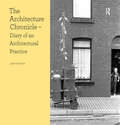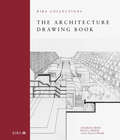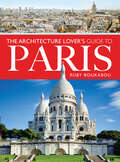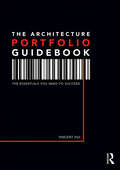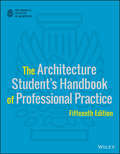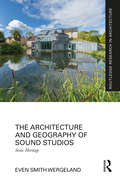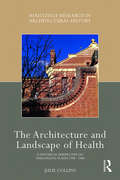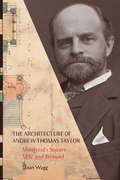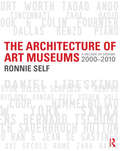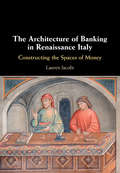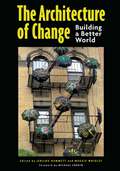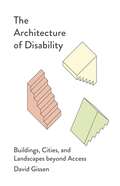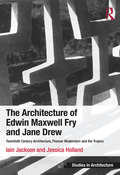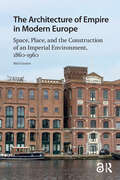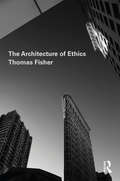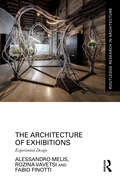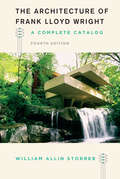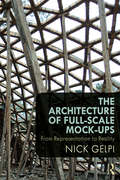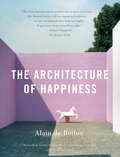- Table View
- List View
The Architectural Plates from the "Encyclopedie" (Dover Architecture)
by Denis DiderotFrom Diderot's monumental illustrated record of 18th-century European arts and sciences: elegant renderings of architectural landmarks; drawings and plans for windmills, bridges and boats; renderings of palatial interiors and furnishings; elevations and floor plans for many well-known European theaters; scenes of 18th-century craftsmen at work in the building trades; and much more.
The Architecture Book (DK Big Ideas)
by DKLearn about key concepts behind the world&’s most incredible buildings in The Architecture Book.Part of the fascinating Big Ideas series, this book tackles tricky topics and themes in a simple and easy to follow format. Learn about Architecture in this overview guide to the subject, great for novices looking to find out more and experts wishing to refresh their knowledge alike! The Architecture Book brings a fresh and vibrant take on the topic through eye-catching graphics and diagrams to immerse yourself in. This captivating book will broaden your understanding of Architecture, with:- A global scope, covering architecture from all over the world- Packed with facts, charts, timelines and graphs to help explain core concepts- A visual approach to big subjects with striking illustrations and graphics throughout- Easy to follow text makes topics accessible for people at any level of understandingThe Architecture Book is a captivating introduction to buildings and the ideas, and principles that make them key to the history and evolution of our built environment - aimed at adults with an interest in the subject and students wanting to gain more of an overview. Here you&’ll discover the most important ideas, technologies, and movements in the history of architecture and structural engineering, through exciting text and bold graphics.Your Architecture Questions, Simply ExplainedLearn about the evolution of construction, from ancient and classical architecture through Medieval, Gothic, and Renaissance buildings, Baroque and Rococo, to 19th-century emerging modernism and postmodernism and glittering skyscrapers. If you thought it was difficult to learn about buildings and the ideas behind them, The Architecture Book presents key information in an easy to follow layout. Explore architectural movements, styles and celebrated buildings from all over the world, and stunning religious structures from mosques to churches, stupas to pagodas and temples.The Big Ideas SeriesWith millions of copies sold worldwide, The Architecture Book is part of the award-winning Big Ideas series from DK. The series uses striking graphics along with engaging writing, making big topics easy to understand.
The Architecture Chronicle: Diary of an Architectural Practice (Design Research in Architecture)
by Jan KatteinDuring the last 30 years, technological, social, economic and environmental changes have brought about the most dramatic evolution to architectural practice that has taken place since the profession emerged during the Italian Renaissance. Whilst these changes have transformed the way architects work, few contemporary books discuss architectural practice. The Architecture Chronicle sets out to define the role of the contemporary architect in the light of these changes. Most books on architecture start when a building is complete, carefully editing out any evidence of the design and production process. The Architecture Chronicle engages with the design and production process. It investigates how and by whom design decisions are made and executed. Chapter 1 is a diary reporting on the design and realisation of five stage sets and one urban intervention over a period of four years, starting on 16 December 2003. The diary is intercepted by references that are, where appropriate, carefully integrated in the overall narrative. Chapter 2 reflects on the diary to discover patterns and cross-references and to draw conclusions. The contemporary architect can be defined as three distinct characters. The architect-inventor challenges conventions and questions the social status quo. The architect-activist transgresses the boundary of the profession and enters the construction process. The architect-arbitrator engages the audience to realise the ambitious project. The Architecture Chronicle concludes that the contemporary architect still draws and writes, but that it is often the architect’s ability to engage and direct that asserts his or her status. To assert his or her status in the design team, the architect’s ability to talk and to act is more important than his or her ability to draw and write.
The Architecture Drawing Book: RIBA Collections
by Charles Hind Fiona Orsini Susan PughA club house in a castle in the West End of London, complete with battlements and turrets, from 1882. A design for the post-war reconstruction of the City of London in 1945. A fantasy landscape featuring Le Corbusier’s Capriccio of Notre-Dame du Haut in ruins. A section of a 19th-century townhouse, showing a slice of the staircase wallpaper winding from deep navy on the ground floor to pale sky blue at the top. This is a treasury of architectural drawing from the 16th century to the present day. Exploring both how and why architects draw, it offers a rich visual history from Palladio, Inigo Jones and Augustus Pugin to contemporaries such as Richard Rogers, Foster Associates and Zaha Hadid, via Sir Christopher Wren, George Gilbert Scott and Erno Goldfinger, and everything else in between. From back-of-envelope concept sketches to painstaking pen and ink perspectives, exploded axonometrics and born-digital drawings, this book celebrates the full gamut of architectural representation. With over 200 lush, full-colour reproductions, this is a window into soul of architectural drawing over the past five hundred years. Includes newly digitised, never-seen-before material from the RIBA Collections, one of the largest architectural archives in the world. Explores rare drawings and designs from John Nash, Sir Edwin Lutyens, Frank Lloyd Wright and many more. Insightful commentary alongside each drawing ensures that they are as accessible and engaging as possible. Wide-ranging in scope, this book will both inspire and inform.
The Architecture Lover's Guide to Paris (City Guides)
by Ruby BoukabouDiscover the architectural history behind Paris’s iconic building, famous landmarks, and charming neighborhoods with this handy visual guidebook.As you stroll the streets of Paris, this informative volume will help you unlock the secrets of the city’s beguiling beauty. Covering the major landmarks as well as dozens of lesser-known architectural gems, The Architecture Lover’s Guide to Paris puts essential history and fascinating details at your fingertips. Whether you are a Paris regular or visiting for the first time, this guide will help you understand how the city acquired its unique design palette. It also offers self-guided walking tours and suggestions of some of the best hotels, restaurants, cafés, churches, parks and more. You’ll discover ancient Roman baths, 17th century mansions, Art Deco theaters, and contemporary cultural complexes. You’ll also find out where to kick back, cocktail or mock-tail in hand, with a panoramic view over the capital. Written by Ruby Boukabou, author of The Art Lover’s Guide to Paris, this book is the perfect companion for anybody intrigued by the City of Light.
The Architecture Lover's Guide to Rome (City Guides)
by Elizabeth F. HeathAn informed, photo-filled guide to “all of the essential stopping places [with] terrifically detailed information on the architectural joys of Rome.” —Books MonthlyRome’s architectural remains date as far back as the city’s founding in the 8th century BCE. The primitive settlement that began on the Palatine Hill grew over the next thousand years to the caput mundi—the capital of the world—the largest, most powerful presence in the ancient Western world. Along the way, Rome’s architectural styles, whether developed organically or appropriated from the cultures it subjugated and absorbed, were physical evidence of the politics, propaganda, and pragmatism of the times.Written for readers passionate about Rome and how its architecture is inimitably linked to its history, The Architecture Lover’s Guide to Rome is the armchair architect’s tour of the Eternal City. It provides a timeline that begins with the founding of Rome and documents its significant architectural monuments and styles through the millennia, with photos, maps and practical information for visiting.
The Architecture Lover’s Guide to London (City Guides)
by Sian LyeSince the early days as rolling hills crisscrossed with streams, London has come a long way to be one of the most exciting and innovative cities in the world. From the first Roman settlement 2000 years ago to the high tech and high rise buildings of today, the history of London is a story of experimentation, determination and triumph. A city at the cutting edge of style and fashion, rising from every fire, every attack, every setback. The Architecture Lover’s Guide to London takes a journey through history, looking at some of the most significant buildings, as well as the people who have shaped this city.
The Architecture Portfolio Guidebook: The Essentials You Need to Succeed
by Vincent HuiThe Architecture Portfolio Guidebook shows you how to make portfolios for both academic and professional needs to provide reviewers exactly what they are looking for. In school, architecture curricula nurture the knowledge and skills to develop design work to varying levels of presentation. In the profession, those skills are further developed and applied in the creation of the built environment. In both contexts, a portfolio is a core component for admission and advancement. This book provides key strategies to: • develop an understanding of the unique needs of professional and academic organizations; • identify applicants’ key differentiators; • highlight how applicants present themselves in their portfolios to address institutional needs; • create successful reinforcing documentation; • communicate using portfolios. Rather than proposing generic solutions, this book details the successful practices for portfolio creation by addressing portfolio creation academically and professionally. Supporting insights and examples from leading academics and architects from around the world reinforce the themes presented in this guidebook. An ideal read for students and professionals of architecture, landscape architecture, interior design, and urban design, looking to advance their studies and careers.
The Architecture Student's Handbook of Professional Practice
by American Institute of ArchitectsWritten by The American Institute of Architects, this is the definitive textbook on practice issues written specifically for architecture students. Specifically written for emerging architects, this is the first unabbreviated guide specifically for architecture students about to begin their careers. It is required reading in a professional practice course that architecture students must take within their final two years of school.
The Architecture and Geography of Sound Studios: Sonic Heritage (Routledge Research in Architecture)
by Even Smith WergelandThis is a book about sound studios, focusing on their architectural and geographical aspects. It explores how music is materialized under specific spatial and technological conditions and the myths associated with this process.Through ten in-depth studies, it examines the design, evolution and current function of sound studios amidst economic and technological shifts in the music industry. Traditional studios are in flux between the past and future. The industry, while steeped in romanticism and nostalgia, also embraces forward-driven pragmatism and an extensive reuse culture, encompassing heritage audio, building materials and existing buildings. A surprisingly diverse architectural heritage, the most significant feature is the host building, the framework around the studio capsule. Many traditional studios adapt to digitalization with hybrid solutions, reflecting a shift toward smaller, more versatile spaces. In a time when recordings in theory can happen anywhere, destination studios must excel to attract clients, balancing historical legacies with diversification. Although they may be easy to deconstruct, many of the myths endure, sustaining ideas of landmark recordings, unique locations and distinct remnants of sonic heritage. Courtesy of their capacity to keep the past alive in the present, traditional sound studios are best described as museums that work.This book aims to reach scholars and students with an interest in history, theory and preservation, as well as practicing architects and architectural students who wish to find out more about the relationship between sound and space, acoustic design and retrofitting of historical buildings into specialized functions. It also aims to reach practicing musicians, producers, music students and music scholars.
The Architecture and Landscape of Health: A Historical Perspective on Therapeutic Places 1790-1940 (Routledge Research in Architectural History)
by Julie CollinsThe Architecture and Landscape of Health explores buildings and landscapes that were designed to treat or prevent disease in the era before pharmaceuticals and biomedicine emerged as first line treatments. Written from an architectural perspective, it examines the historical relationship between health and place through the emergence of dedicated therapeutic building types from the late eighteenth to the early twentieth century, a time when the environment was viewed as integral to the health of both the individual and the population. This book provides an overview of ideas surrounding health and place and their impact on architecture and designed landscapes. Different therapeutic buildings and places are examined, including public parks, asylums, sanatoria, leprosaria, quarantine stations, public baths and healthy homes. Each chapter outlines the medical context, common therapies, a history of buildings designed in response to these, and an examination of how such places were perceived to have functioned. Illustrated using geographically and temporally diverse examples, the book includes designs drawn from locations across the world including Europe, the Americas, Africa, Australia and Asia. The Architecture and Landscape of Health identifies and examines moments in the conversation between health and design, and is a timely look back on the resultant buildings and places, offering insights which could inform the design of therapeutic places of the future. An ideal read for researchers, academics and upper-level postgraduate students interested in architecture, and architectural history, particularly relating to healthcare design and medical history.
The Architecture of Andrew Thomas Taylor
by Susan WaggBy the year 1900, architect Andrew Taylor had designed Bank of Montreal branches across the continent and much of McGill University, helped found the McGill School of Architecture, and played a critical role in creating the first professional organization for Quebec architects. In The Architecture of Andrew Thomas Taylor, Susan Wagg presents a groundbreaking study of the life and work of a major figure in nineteenth-century Canadian architecture. Born in Edinburgh and trained in Scotland and England, Taylor spent two decades in Canada between 1883 and 1904, designing some of Montreal's most iconic landmarks. Wagg places his career amidst the wealth of opportunities provided by Canada's high society and captains of industry. Taylor's Canadian relatives, Montreal's powerful Redpath family, brought him into contact with the small group of financiers and entrepreneurs who controlled Canada's destiny. With the support of such influential patrons as Sir William Macdonald and the Bank of Montreal, Taylor successfully confronted dramatic changes in building technology as iron and steel were increasingly used and buildings grew ever taller. He innovatively adapted English and American styles to the Canadian environment, designing structures distinctively suited to their place in history. Positioning Taylor's extensive designs within the context of his time, The Architecture of Andrew Thomas Taylor firmly establishes his work as a cornerstone of Canadian architecture.
The Architecture of Andrew Thomas Taylor: Montreal's Square Mile and Beyond
by Susan WaggBy the year 1900, architect Andrew Taylor had designed Bank of Montreal branches across the continent and much of McGill University, helped found the McGill School of Architecture, and played a critical role in creating the first professional organization for Quebec architects. In The Architecture of Andrew Thomas Taylor, Susan Wagg presents a groundbreaking study of the life and work of a major figure in nineteenth-century Canadian architecture. Born in Edinburgh and trained in Scotland and England, Taylor spent two decades in Canada between 1883 and 1904, designing some of Montreal's most iconic landmarks. Wagg places his career amidst the wealth of opportunities provided by Canada's high society and captains of industry. Taylor's Canadian relatives, Montreal's powerful Redpath family, brought him into contact with the small group of financiers and entrepreneurs who controlled Canada's destiny. With the support of such influential patrons as Sir William Macdonald and the Bank of Montreal, Taylor successfully confronted dramatic changes in building technology as iron and steel were increasingly used and buildings grew ever taller. He innovatively adapted English and American styles to the Canadian environment, designing structures distinctively suited to their place in history. Positioning Taylor's extensive designs within the context of his time, The Architecture of Andrew Thomas Taylor firmly establishes his work as a cornerstone of Canadian architecture.
The Architecture of Art Museums: A Decade of Design: 2000 - 2010
by Ronnie SelfAs a building type, art museums are unparalleled for the opportunities they provide for architectural investigation and experimentation. They are frequently key components of urban revitalization and often push the limits of building technology. Art museums are places of pleasure, education and contemplation. They are remarkable by their prominence and sheer quantity, and their lessons are useful for all architects and for all building types. This book provides explicit and comprehensive coverage of the most important museums built in the first ten years of the 21st Century in the United States and Europe. By dissecting and analyzing each case, Ronnie Self allows the reader to get under the skin of each design and fully understand the process behind these remarkable buildings. Richly designed with full technical illustrations and sections the book includes the work of Tadao Ando, Zaha Hadid, Peter Cook & Colin Fournier, Renzo Piano, Yoshi Taniguchi, Herzog & de Meuron, Jean Nouvel, SANAA, Daniel Libeskind, Diller Scofidio & Renfro, Steven Holl, Coop Himmelb(l)au, Bernard Tschumi, Sauerbruch Hutton, and Shigeru Ban & Jean de Gastines. Together these diverse projects provide a catalogue of design solutions for the contemporary museum and a snapshot of current architectural thought and culture. One of few books on this subject written by an architect, Self’s analysis thoroughly and critically appraises each project from multiple aspects and crucially takes the reader from concept to building. This is an essential book for any professional engaged in designing a museum.
The Architecture of Banking in Renaissance Italy: Constructing the Spaces of Money
by Lauren JacobiOver the course of the twelfth and thirteenth centuries, European society confronted rapid monetization, a process that has been examined in depth by economic historians. Less well understood is the development of architecture to meet the needs of a burgeoning mercantile economy in the Late Middle Ages and early modern period. In this volume, Lauren Jacobi explores some of the repercussions of early capitalism through a study of the location and types of spaces that were used for banking and minting in Florence and other mercantile centers in Europe. Examining the historical relationships between banks and religious behavior, she also analyzes how urban geographies and architectural forms reveal moral attitudes toward money during the onset of capitalism. Jacobi's book offers new insights into the spaces and locations where pre-industrial European banking and minting transpired, as well as the impact of religious concerns and financial tools on those sites.
The Architecture of Change: Building a Better World
by Jerilou Hammett Maggie WrigleyThe Architecture of Change: Building a Better World is a collection of articles that demonstrates the power of the human spirit to transform the environments in which we live. This inspiring book profiles people who refused to accept that things couldn&’t change, who saw the possibility of making something better, and didn&’t esitate to act.Breaking down the stereotypes surrounding &“socially engaged architecture,&” this book shows who can actually impact the lives of communities. Like Bernard Rudofsky&’s seminal Architecture Without Architects, it explores communal architecture produced not by specialists but by people, drawing on their common lives and experiences, who have a unique insight into their particular needs and environments. These unsung heroes are teachers and artists, immigrants and activists, grandmothers in the projects, students and planners, architects and residents of some of our poorest places. Running through their stories is a constant theme of social justice as an underlying principle of the built environment. This book is about opening one&’s eyes to new ways of interpreting the world, and how to go about changing it.
The Architecture of Country Houses: Including Designs For Cottages, Farm Houses, And Villas, With Remarks On Interiors, Furniture, And The Best Modes Of Warming And Ventilating (classic Reprint) (Dover Architecture)
by Andrew J. DowningThroughout the early Victorian period, American domestic architecture was dominated by the ideas and designs of Andrew Jackson Downing (1815-52). Downing, who was America's first important landscape architect, was instrumental in establishing a well-styled, efficient, yet low-priced house that offered many features that previously only mansions could provide. His designs were widely spread both by his books and by periodical republication.Downing's most important work was his Architecture of Country Houses (1850), which passed through nine editions by 1866 and served as the stylebook for tens, perhaps hundreds of thousands of homes throughout the Eastern United States. It contains 34 designs for model homes (country house in this context simply meaning a separate house, as opposed to a town house), with elevations, floor plans, and discussion of design, construction, and function. The English country house of the period is the ground style, upon which other styles are overlaid; designs showing Gothic, French, Italian, and Elizabethan styles allow the user considerable choice. In many ways these designs form one of the first steps toward the modern house, with avowed emphasis on function and convenience, expression of personality, Catholicism of taste, and concord with environment. Decoration, of course, was not frowned upon.Most valuable today is the author's full, thorough discussion of many other aspects of the early Victorian house: aesthetic concerns of architecture, adjustment to locality, materials, construction, costs, floor plan, roofing, shingling, painting, chimneys, and fireplaces, interior woodwork, wallpapering, decoration, furnishing, ventilation, sanitation, central heating, and landscaping. Since most of the houses concerned have been destroyed or altered, and practically no living situations have been preserved, this book is indispensable to everyone interested in early American culture, interior decoration, restoration, or Victorian architecture. It is far and away the richest source for the period.
The Architecture of Disability: Buildings, Cities, and Landscapes beyond Access
by David GissenA radical critique of architecture that places disability at the heart of the built environment Disability critiques of architecture usually emphasize the need for modification and increased access, but The Architecture of Disability calls for a radical reorientation of this perspective by situating experiences of impairment as a new foundation for the built environment. With its provocative proposal for &“the construction of disability,&” this book fundamentally reconsiders how we conceive of and experience disability in our world. Stressing the connection between architectural form and the capacities of the human body, David Gissen demonstrates how disability haunts the history and practice of architecture. Examining various historic sites, landscape designs, and urban spaces, he deconstructs the prevailing functionalist approach to accommodating disabled people in architecture and instead asserts that physical capacity is essential to the conception of all designed space. By recontextualizing the history of architecture through the discourse of disability, The Architecture of Disability presents a unique challenge to current modes of architectural practice, theory, and education. Envisioning an architectural design that fully integrates disabled persons into its production, it advocates for looking beyond traditional notions of accessibility and shows how certain incapacities can offer us the means to positively reimagine the roots of architecture.
The Architecture of Edwin Maxwell Fry and Jane Drew: Twentieth Century Architecture, Pioneer Modernism and the Tropics (Ashgate Studies in Architecture)
by Iain Jackson Jessica HollandMaxwell Fry and Jane Drew were pioneers of Modern Architecture in Britain and its former colonies from the late 1920s through to the early 1970s. As a barometer of twentieth century architecture, their work traces the major cultural developments of that century from the development of modernism, its spread into the late-colonial arena and finally, to its re-evaluation that resulted in a more expressive, formalist approach in the post-war era. This book thoroughly examines Fry and Drew's highly influential 'Tropical Architecture' in West Africa and India, whilst also discussing their British work, such as their post World War II projects for the Festival of Britain, Harlow New Town, Pilkington Brothers’ Headquarters and Coychurch Crematorium. It highlights the collaborative nature of Fry and Drew's work, including schemes undertaken with Elizabeth Denby, Walter Gropius, Denys Lasdun, Pierre Jeanneret and Le Corbusier. Positioning their architecture, writing and educational endeavours within a wider context, this book illustrates the significant artistic and cultural contributions made by Fry and Drew throughout their lengthy careers.
The Architecture of Empire in Modern Europe: Space, Place, and the Construction of an Imperial Environment, 1860-1960 (Landscape and Heritage Studies)
by Miel GrotenEmpires stretched around the world, but also made their presence felt in architecture and urban landscapes. The Architecture of Empire in Modern Europe traces the entanglement of the European built environment with overseas imperialism in the nineteenth and twentieth centuries. As part of imperial networks between metropole and colonies, in cities as diverse as Glasgow, Hamburg, or Paris, numerous new buildings were erected such as factories, mission houses, offices, and museums. These sites developed into the physical manifestations of imperial networks. As Europeans designed, used, and portrayed them, these buildings became meaningful imperial places that conveyed the power relations of empire and Eurocentric self-images. Engaging with recent debates about colonial history and heritage, this book combines a variety of sources, an interdisciplinary approach, and an international scope to produce a cultural history of European imperial architecture across borders.
The Architecture of Ethics
by Thomas FisherEthics is one of the most important and least understood aspects of design practice. In his latest book, Thomas Fisher shows how ethics are inherent to the making of architecture – and how architecture offers an unusual and useful way of looking at ethics. The Architecture of Ethics helps students in architecture and other design disciplines to understand the major approaches to ethics and to apply them to the daily challenges they face in their work. The book covers each of the four dominant approaches to ethics: virtue ethics, social contract ethics, duty ethics, and utilitarian ethics. Each chapter examines the dilemmas designers face from the perspective of one of these categories. Written in an accessible, jargon-free style, the text also features 100 illustrations to help integrate these concepts into the design process and to support visual understanding. Ethics is now a required part of accredited architecture programs, making this book essential reading for all students in architecture and design.
The Architecture of Exhibitions: Experiential Design (Routledge Research in Architecture)
by Alessandro Melis Rozina Vavetsi Fabio FinottiThe Architecture of Exhibitions embarks on a comprehensive exploration of creativity and design innovation within exhibition spaces. It describes the fundamental principles of exhibition design, tracing the origins of creativity and considering its evolutionary significance.The book challenges conventional boundaries imposed by rigid classifications, drawing on heuristic studies in biology and the transformative concept of exaptation. It questions the traditional separations between art, science and technology, which often hinder innovation. By advocating for an interdisciplinary approach, it reimagines creativity that transcends conventional limits. Through practice-based research, multidisciplinary case studies and technological innovations, with a focus on generative AI, the book illustrates how modern exhibition spaces actively engage with their audiences, highlighting their profound impact beyond academic discourse.This book is designed for curators, designers and scholars who are passionate about the future of exhibition spaces. It offers a comprehensive understanding through its four-part structure, making it an essential read for anyone interested in the dynamic interplay between art, technology and society. The book is also designed as an instrument for the education of architecture, design and art students.
The Architecture of Frank Lloyd Wright: A Complete Catalog
by William AllinFrom sprawling houses to compact bungalows and from world-famous museums to a still-working gas station, Frank Lloyd Wright’s designs can be found in nearly every corner of the country. While the renowned architect passed away more than fifty years ago, researchers and enthusiasts are still uncovering structures that should be attributed to him. William Allin Storrer is one of the experts leading this charge, and his definitive guide, The Architecture of Frank Lloyd Wright, has long been the resource of choice for anyone interested in Wright. Thanks to the work of Storrer and his colleagues at the Rediscovering Wright Project, thirty-seven new sites have recently been identified as the work of Wright. Together with more photos, updated and expanded entries, and a new essay on the evolution of Wright’s unparalleled architectural style, this new edition is the most comprehensive and authoritative catalog available. Organized chronologically, the catalog includes full-color photos, location information, and historical and architectural background for all of Wright’s extant structures in the United States and abroad, as well as entries for works that have been demolished over the years. A geographic listing makes it easy for traveling Wright fans to find nearby structures and a new key indicates whether a site is open to the public. Publishing for Wright’s sesquicentennial, this new edition will be a trusted companion for anyone embarking on their own journeys through the wonder and genius of Frank Lloyd Wright.
The Architecture of Full-Scale Mock-Ups: From Representation to Reality
by Nick GelpiThe Architecture of Full-Scale Mock-Ups looks at the theory and contemporary practice of creating full-scale architectural mock-ups. This book serves as an introduction to the various forms of full-scale mock-ups which occur today. To broaden the definition of mock-ups, Nick Gelpi dives deep into the use of mock-ups in seven high-profile and global contemporary case studies. Instead of the presentation drawings and final building photos, the documentation of case studies relies on process photos, interviews, and moments of tension in the execution of each building. With never-before-published content, case studies include buildings from all over the world, including the Quincho Tia Coral and Teleton Building, Copper House II, the Pérez Art Museum Miami, the Cité de l’Océan et du Surf Museum, and more. Investigating unique case studies to answer how and when full-scale mock-ups occur today, this book is ideal for professionals and students of architecture studying materials and representation, design-build, and professional practice.
The Architecture of Happiness
by Alain De BottonBestselling author Alain de Botton considers how our private homes and public edifices influence how we feel, and how we could build dwellings in which we would stand a better chance of happiness.In this witty, erudite look at how we shape, and are shaped by, our surroundings, Alain de Botton applies Stendhal's motto that "Beauty is the promise of happiness" to the spaces we inhabit daily. Why should we pay attention to what architecture has to say to us? de Botton asks provocatively.With his trademark lucidity and humour, de Botton traces how human needs and desires have been served by styles of architecture, from stately Classical to minimalist Modern, arguing that the stylistic choices of a society can represent both its cherished ideals and the qualities it desperately lacks. On an individual level, de Botton has deep sympathy for our need to see our selves reflected in our surroundings; he demonstrates with great wisdom how buildings -- just like friends -- can serve as guardians of our identity. Worrying about the shape of our sofa or the colour of our walls might seem self-indulgent, but de Botton considers the hopes and fears we have for our homes at a new level of depth and insight. When shopping for furniture or remodelling the kitchen, we don't just consider functionality but also the major questions of aesthetics and the philosophy of art: What is beauty? Can beautiful surroundings make us good? Can beauty bring happiness? The buildings we find beautiful, de Botton concludes, are those that represent our ideas of a meaningful life. The Architecture of Happiness marks a return to what Alain does best -- taking on a subject whose allure is at once tantalizing and a little forbidding and offering to readers a completely beguiling and original exploration of the subject. As he did with Proust, philosophy, and travel, now he does with architecture.From the Hardcover edition.


